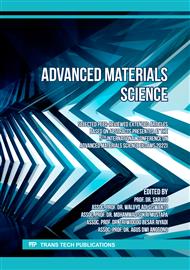[1]
E.R. Sahakyan, Reactions in mixtures of aluminosilicates with sodium hydroxide and their thermodynamics // Proceedings of the Scientific Research Institute of Stone and Silicates, 1975, № 8, pp.209-212.
Google Scholar
[2]
E.R. Sahakyan, New artificial cellular materials, lightweight aggregates and products based on them // Dr.Sc. MCHTI named after Mendeleev, (1992).
Google Scholar
[3]
E.R. Sahakyan, A.A. Arzumanyan, N. Muradyan, Inorganic Polymeric Materials Based on Natural Silicate and Aluminosilicate Raw Materials. 13-th International Conference Contemporaly Architecture AMD Construction,/CCPAC 2021, Armenia.
DOI: 10.4028/www.scientific.net/kem.906.1
Google Scholar
[4]
S.A. Bakhchisaraytseva, E.R. Sahakyan, Investigation by IR method of phase transformations in the process of obtaining foam stone // Inorganic materials - 1971.-V.7-№11 - pp.2057-2060.
Google Scholar
[5]
E.R. Sahakyan, B.N. Frenkel, G.M. Matveev, Thermodynamic analysis of reactions in mixtures of quartz with sodium hydroxide // Journal of Applied Chemistry, 1973, No. 11, pp.2421-2424.
Google Scholar
[6]
E.R. Sahakyan, M.L. Darbinyan, Dilatometric study of foam stone sintering // Neoganic materials 1970.-T.VI-№6 - pp.1161-1164.
Google Scholar
[7]
A.A. Akhundov, G.A. Petrikhina, A.I. Polinkovskaya, V.L. Kryuzhalsky, Firing in a fluidized bed in the production of building materials - / / M: Znaniya, 1969, p.32.
Google Scholar
[8]
V.I. Galyant, V.I. Primenko, Calculation of the true heat capacity of silicate glasses // Glass and Ceramics, 1988, No. 4, pp.9-10.
DOI: 10.1007/bf00704509
Google Scholar
[9]
Thermodynamic properties of individual substances. // Reference edition - M: Nauka 1982, 902 p.
Google Scholar
[10]
V.V. Babushkin, M.M. Matveev, O.P. Mchedlov-Petrosyan, Thermodynamics of silicates // M: Stroyizdat, 1986, 406p.
Google Scholar
[11]
M.P. Vulakevich, Thermophysical properties of water and steam. // - M: Engineering, 1967, p.160.
Google Scholar
[12]
Brief reference book on chemistry. –// Kiev: Ed. Academy of Sciences of the Ukrainian SSR, pp.1962-659.
Google Scholar
[13]
Key Engineering Materials // ISSN: 1662-9793, Vol. 828, pp.146-152, 2020 Trans Tech Publications LTD, Switzerland.
Google Scholar
[14]
Apkaryan, Porous glass – Ceramic materials modified with light-melting and organic additives for engeneering purposes: production, structure and thermophysical properties, // Tomsk, (2018).
Google Scholar
[15]
Gnesin, Silicon carbide materials, Metallurgy, // Moscow, (1977).
Google Scholar
[16]
Emma Saakyan, Artavazd Arzumanyan, Gagik Galstyan New Energy Efficient Technology of Cellular Glass Key Engineering Materials // ISS:1662-9795, Vol. 828, pp.146-2020 Trans Tech Publications LTD Switzerland.
DOI: 10.4028/www.scientific.net/kem.828.146
Google Scholar



